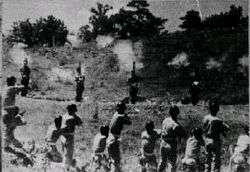National Defense Corps incident


The National Defense Corps incident (Korean: 국민방위군 사건, Hanja: 國民防衛軍事件) was a death march that occurred in the winter of 1951 during the Korean War.
On 11 December 1950, South Korea issued an act establishing the National Defense Corps. South Korean citizens aged 17 to 40, excluding military, police and government officials, were drafted into the National Defense Corps.[1][2] The Syngman Rhee government adopted officers from Great Korean Youth Association (대한청년단; 大韓靑年團), which was a pro-Rhee Syngman group, into the Corps.
Immediately, 406,000 drafted citizens were deployed in 49 training units,[3] then National Defense Corps soldiers were ordered to march southward on the Korean peninsula under the Chinese offensive. However, funds for food purchases were embezzled by the National Defense Corps Commander Kim Yungun (Kim Yun-keun) (Kim Yoon-keun), son-in-law of Defence minister Shin Sung-mo.[4] Approximately 300,000 men were lost to death or desertion during the three week, 300-mile "death march".[5] By June 1951, when an investigating committee made known its findings, it was reported that some 50,000[6] to 90,000 soldiers starved to death or died of disease on the march and in the training camps.[2][4][7]
On 30 April 1951, the National Assembly of South Korea adopted a resolution on disbandment of the National Defense Corps.[1] The National Assembly investigation showed that the commanding officers embezzled one billion won, and tens of millions of won was misappropriated to President Rhee Syngman's political fund.[6]
In May 1951, vice-president Yi Si-yeong resigned. In June, it was reported that five billion won in funds for the National Defense Corps had been embezzled.[8] On 12 August 1951, five commanding officers were executed as persons in charge of the incident.[1][9]
References
- 1 2 3 진실화해위 `국민방위군' 직권조사. Yonhap News (in Korean). Newsis. 2007-03-09. Retrieved 2010-07-14.
- 1 2 Terence Roehrig (2001). Prosecution of Former Military Leaders in Newly Democratic Nations: The Cases of Argentina, Greece, and South Korea. McFarland & Company. p. 139. ISBN 978-0-7864-1091-0.
- ↑ "국민방위군 수만명 한국전때 허망한 죽음" 간부들이 군수품 착복…굶어죽거나 전염병 횡사 진실화해위, 매장지 등 확인…국가에 사과 권고 (in Korean). Hankyoreh. 2010-09-07.
- 1 2 Sandler, Stanley. The Korean War: no victors, no vanquished. Univ Pr of Kentucky. p. 224. ISBN 0-8131-0967-1.
- ↑ "50,000 KOREANS DIE IN CAMPS IN SOUTH; Government Inquiry Confirms Abuse of Draftees--General Held for Malfeasance". New York Times. US. 1951-06-13. p. 3. Retrieved 2010-07-22.
More than 50,000 South Korean draftees have died of starvation or disease since last December in training camps, the chairman of an investigating committee said today....[T]he investigation committee had substantiated ... the details of a 300 mile 'death march'.... During the three weeks of forced marching through snow in the bitter cold of winter, [the investigator] said, approximately 300,000 men deserted or died along the way.
- 1 2 국민방위군 사건 (in Korean). National Archives of Korea. Retrieved 2010-07-20.
- ↑ '국민방위군' 희생자 56년만에 '순직' 인정. Newsis (in Korean). 2007-10-30. Retrieved 2010-07-14.
- ↑ "SOUTH KOREAN AIDE QUITS; Defense Minister Says He Was Implicated in Scandals.". New York Times. US. 1951-06-04. Retrieved 2010-07-22.
- ↑ "ROK General Executed for Army Thefts". Los Angeles Times. US. 1951-08-14. p. 6. Retrieved 2010-07-22.
See also